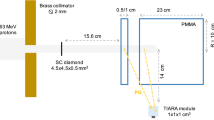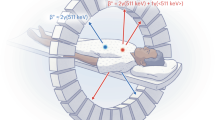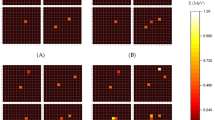Abstract
IN order to study the decay schemes of radio-isotopes, we have used two scintillation spectrometers in coincidence. The construction of the spectrometers used and the measuring technique have been described earlier1. The pulses from one of the spectrometers are analysed by a single-channel pulse analyser. Pulses corresponding to a certain energy-range are selected by the channel, and the output pulses from the analyser are fed to the sweep-trigger of an oscilloscope. The pulses from the second spectrometer are led to the vertical deflexion plates of the oscilloscope. Only pulses which are in coincidence with those selected by the pulse analyser then appear on the screen. The coincidence-rate is 10–100 pulses per minute. The screen is photographed for a few hours. A picture of the pulse–height distribution is then obtained on the photographic plate; the density at a particular point is a measure of the number of pulses with the corresponding height. The density is determined by means of a microphotometer, and, from the known density curve of the plate, one obtains the pulse–height distribution curve. With the pulse analyser one thus selects pulses corresponding to a certain beta- or gamma-ray energy, and from the shape of the coincidence spectrum obtained one can infer what gamma-rays are in coincidence with the selected radiation.
This is a preview of subscription content, access via your institution
Access options
Subscribe to this journal
Receive 51 print issues and online access
$199.00 per year
only $3.90 per issue
Buy this article
- Purchase on SpringerLink
- Instant access to full article PDF
Prices may be subject to local taxes which are calculated during checkout
Similar content being viewed by others
References
Johansson, S. A. E., Nature, 165, 396 (1950); Arkiv för Fysik, 2, 171 (1950); 3, 533 (1951).
Siegbahn, K., Phys. Rev., 77, 233 (1950).
Kern, B. D., Zaffarano, D. J., and Mitchell, A. C. G., Phys. Rev., 73, 1142 (1948).
Metzger, F., and Deutsch, M., Phys. Rev., 74, 1640 (1948).
Bell, P. R., Cassidy, J. M., and Kelley, G. G., Phys. Rev., 82, 103 (1951).
Ketelle, B. H., Zeldes, H., Brosi, A. R., and Dandl, R. A., Phys. Rev., 84, 585 (1951).
Author information
Authors and Affiliations
Rights and permissions
About this article
Cite this article
ALMQVIST, S., JOHANSSON, S. Scintillation Spectrometer Studies on the Decay Schemes of Silver-110, Antimony-124 and Iodine-131. Nature 170, 583–584 (1952). https://doi.org/10.1038/170583b0
Issue date:
DOI: https://doi.org/10.1038/170583b0



